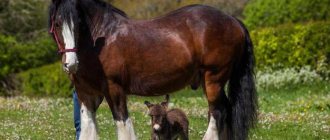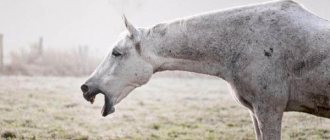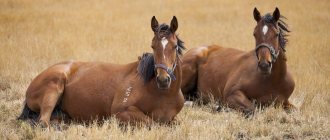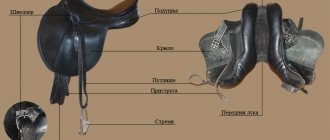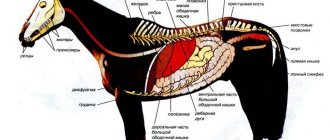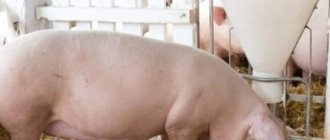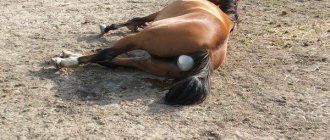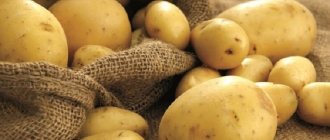Graceful animals differ from each other in size: there are both lightweight and heavyweight breeds. The more a horse weighs, the higher its pulling power and carrying capacity. This indicator affects not only the animal’s performance, but also its health.
Weight groups
In total, there are four weight groups of ungulates. This division is arbitrary, but it gives a general idea of the spread of weight between different breeds and subgroups.
The following groups are distinguished:
- Pony. They weigh on average 100-200 kilograms. These horses are not intended for work and are considered more decorative animals. The main breeds of this group are Exmoor, Welsh, and Falabella.
- Light horses - 200-400 kg. They have a decorative focus and participate in exhibitions and shows. Breeds: Pinto, American Miniature, Lipizzaner.
- Average - 400-600 kilos. Most often involved in sports and light physical work. The most famous representatives are Kalmyk, Paint Horse, Holstein, Marvari.
- Heavy trucks – 650-1200 kg. Used for heavy physical work. The hardiest and largest breeds are Shire, Bityug, Suffolk, and Clydesdale.
The weight of an adult, fully mature animal must be measured. This is considered the average for the breed. With normal health and development, a horse gains maximum weight between the ages of three and five years. During this period, the final weight category is determined.
General information
Horses have been domesticated by people since before our era. It is believed that the ancestors of the domestic horse were tarpans, which have long since become extinct. These animals have been serving people for many thousands of years , which is why they are mostly found as pets. However, there are regions where they are found naturally.
There are many breeds among domestic representatives. They differ in many ways:
- size;
- head shape;
- addition;
- blossom.
Horses are herbivores. When they graze on pasture, they can eat up to 100 kg of grass per day. In summer they drink 30-60 liters of water, in winter up to 25 liters. Their food needs depend on age and body weight. The animal's diet consists of oats and hay. The latter product is often replaced with straw.
By their nature, these animals are very peaceful, but if necessary, they know how to stand up for themselves. In case of danger, horses use their hooves and teeth. Young stallions living in herds are considered the most courageous.
Depending on the purpose
Poor nutritional status
This is an abnormal condition for the animal's body. It is observed in sick and aged animals, as well as when there is insufficient food. The ungulate suffers from a lack of subcutaneous fat and muscle tissue. Bones may protrude, as if visible through the skin. The shoulder blades and croup bones are visible.
Such horses must be urgently treated and provided with a complete and balanced diet in order to prevent the onset of serious illness.
For each orientation, the characteristic weight that manifests itself with unsatisfactory fatness is different. Emaciated ponies weigh 60-80 kg, light horses - 150, medium - 300-350 and heavy horses - 500-700 kilos.
Sports, training
This norm is relevant for horse racing and cross-country participants. Horses must have a high percentage of muscle in their body, be fit, with a small amount of subcutaneous fat, but very hardy and strong. Most often, such horses have a mass of 500-550 kilos.
Working
This body condition is considered standard for most horses. Horses are active, but do not have overly developed muscles. A small percentage of reserve fat ensures the performance and endurance of these ungulates.
The weight of workhorses varies widely: from 400 to 900 kilograms.
Factory
The main function of these animals is to produce strong and healthy offspring. Such horses are slightly plump, since they receive nutrients in reserve necessary for reproduction.
The weight of hatchery ungulates varies greatly: it should be characteristic of the breed. Therefore, the weight ranges from 50 kilograms for miniature ponies to 1-1.2 tons for heavy Shire ponies.
Exhibition
Such horses must have a beautiful appearance in order to perform at exhibitions and shows. They are moderately well-fed, have developed, but not pronounced muscles. Each horse must represent the best qualities of its breed, so slight deviations are possible: some individuals are more wiry or muscular. As in the previous group, the horse must correspond to the breed.
Weight is considered average for each breed, and ideal values are taken into account. So, a Kyrgyz horse should weigh half a ton, a falabella - 40-55 kg, and a Brabançon - 950 kilos.
How much does a horse weigh: basic facts, table
How much does a horse weigh? This question interests every person who is going to make such a large purchase. Its main characteristics, as well as health indicators, depend on the horse’s weight. If a person has determined the average weight of a horse, he will then be able to properly control its growth, formation, and most importantly, its health.
How much does a horse weigh
Horses, like people, can gain a lot of weight or, conversely, lose weight from improper feeding and exercise. The horse's weight, health and physical condition depend on the diet. The amount of food a horse eats should be 2% of its weight.
Weight group and what it should be
The average weight of a horse, regardless of its age, is divided into groups:
- individuals weighing less than 400 kg are the lightest horses;
- 400-600 kg—average weight of a pet;
- more than 600 kg - heavyweight horses;
- 200 kg and less - ponies.
If you know exactly the weight of an adult horse, you can determine the acceptable load for it. An important factor is fatness. After some time, you will be able to find out what kind of work to use your pet for, and how much it can be loaded.
Horses that have a beautiful breed and participate in various exhibitions are quite well-fed. They have beautiful shiny fur and round shapes. Animals with good sexual activity are classified in the breeding category.
They are mainly used for breeding.
Horses, which have excellent shape, height and low weight, are used for various jobs and also become participants in sports competitions. A horse with poor condition is the result of poor management. This also applies to animals that have been sick often or are already very old.
How to correctly calculate the mass of large individuals
How much does an adult horse weigh? To determine how much a mature horse weighs, a formula invented by a German hippologist is used. Measuring animal weight is very simple; to do this, take the circumference of the individual’s chest and multiply it by a special coefficient, which has its own for each animal. What the coefficient should be is indicated in the table below.
| Light draft animals | 2,7 |
| Draft horse | 3,5 |
| Average pet | 3,1 |
The mass is calculated as follows: mass = 1.455 * (EG) 1.832 (CO) 2.315 (DF) - 580.4. Owners of large pets cannot do without this formula.
The weight of adult horses is determined using the formula of a Russian hippologist. The weight of a horse is determined by multiplying the chest girth number by 6 and subtracting the number 620 from the resulting result. Thoroughbred horses are calculated using a more complex formula.
Once the average weight of an adult horse is known, it is possible to determine how much work the animal can handle and how often it can be used for rural work. Many owners think that a horse can withstand any load. It's a myth: each breed can only support a certain amount of weight.
If the horse is athletic and intended for competition, the rider's weight should not exceed 20% of the horse's weight. When a person weighs more than 30%, the animal experiences severe stress and strain. For example, if the weight of the pet is 400 kg, then the weight of the rider should not exceed 80 kg.
What is the weight of foals at birth?
The horse carries the foal for 11 months. How much a newborn foal weighs depends on the breed of its mother. At birth, a horse should weigh on average 40 kg. Only at this weight can a baby stand on its feet immediately after birth. A few hours after birth, he begins to eat mother's milk.
In order for the foal to grow well and not get sick, it needs to be fed properly, control its weight and monitor its health. Children of heavyweights weigh 50-60 kg at birth. Very weak individuals, born weighing 30 kg, cannot immediately rise to their feet. Such foals are artificially fed so that they gain strength and reach the required weight.
The mass of a small stallion can also be calculated using the formula. The weight of an adult horse, that is, the mother, is divided by 10, the result is how much the baby weighs when born. The weight of a born horse will fluctuate plus or minus 5 kg. A pony weighs much less at birth. Scientists have recorded that the smallest mass of a pony is 2 kg, and the largest is 67 kg.
Important principles for measuring animal parameters
In order to find out how much a horse weighs on average, you need to measure everything correctly and carefully. This is done very simply if you use special formulas and meters for correct measurements.
For example, to measure the volume of the chest, they use a tape on which kilograms are marked for a specific weight group of the animal. The result of chest volume can be determined by measuring the horse's belly at the most convex points.
In order to find out the height of the pet, take the length starting from the withers to the ground.
After all the measurements taken, the resulting numbers are multiplied by a special indicator of body type. Each type of animal has its own number. You can find it out in a special table.
| Heavy horse | 2,58 |
| Average pet | 2,33 |
| The horse is thin | 2,1 |
In order to determine how much weight a horse can bear, you will need the following coefficients:
- well-fed animal - 3.39;
- skinny pets - 3.06.
Such indicators make it possible to learn how to feed your pet correctly, as well as how to monitor its health and growth.
How many years do horses live?
How long an adult pet will live directly depends on what work it will be used for, as well as how much weight the horse will carry. These indicators include the following factors:
- pet breed;
- conditions during detention;
- purpose of an adult pet.
The average age of an adult is 35 years. When an animal lives in the wild, it rarely lives to that age. The average age of individuals used for selection is 30 years. Animals participating in sports live up to 25, but it is worth considering that a pet’s life expectancy depends on the injuries received and the diseases suffered.
HOW TO MEASURE A HORSE'S WEIGHT | A game
Summarize
In order to accurately calculate the weight of a horse, the main thing is to correctly measure all the parameters: height, weight and chest circumference. The weight of a horse directly determines its future life and where it will be used.
The capabilities of such large animals know no bounds: pets are able to bring joy to their owners both through physical beauty and as excellent assistants in various transportation and when planting crops.
Source: https://FermoVed.ru/loshadi/skolko-vesit.html
Weight depending on breed
Pony
How much does a pony weigh? As mentioned above, the average weight of a pony is 1-2 centners, but individuals of relatively small weight are more common - 130-140 kg.
There is a rare breed - the Falabella pony. The weight of these crumbs is only 20-35 kilograms.
Trotters
This breed is muscular, strong and graceful. However, due to the average height - 155-168 centimeters - and “thin” bones, horses weigh relatively little - 500-550 kilograms. This horse has a harmonious “classic” physique.
Budyonnovsky
This breed was developed relatively recently. The height of a Budyonnovsk resident reaches an average of 162-167 centimeters. Due to different directions and types - oriental, massive or characteristic (“traditional”) - the parameters vary in a wide weight range: from 470 to 560 kilograms.
Heavy trucks
This breed of horse is one of the record holders - it is not uncommon for stallions to weigh 1.3-1.4 tons. The height at the withers of 170-175 centimeters is considered small for this group of animals. This, combined with muscularity, provides a very large mass - young females weigh 850-1100 kilograms, stallions - 1-1.2 tons.
Shires
The average weight of a horse of this breed is simply colossal - 1200-1400 kilograms. Some males reached a mass of one and a half tons! Moreover, the animal is very large, has developed muscle mass and a good layer of fat. The height of the representatives of the breed is 175-190 centimeters, but there are often cases when heavy Shiiras grow up to two meters at the withers.
Brabançons
Otherwise they are also called Belgian heavy trucks. The animals have a small mass for their group - 800-1000 kg.
They are relatively short - 160-175 centimeters, and are distinguished by highly developed, even slightly disproportionate legs. The build is stocky and the neck is short. A distinctive feature is strong shoulders and a very voluminous body.
What is the height of a horse at the withers
A horse's height is usually measured from the ground to the highest point of the withers. The height of a horse depends on its breed. All animals are divided into groups according to height and body length:
- dwarf and ponies - up to 120 cm at the withers;
- short - from 100 to 145 cm;
- average height - 150-165 cm;
- tall - over 170 cm.
The tallest horse breeds are the Brabançon, Clydasle and Shire. Their height at the withers exceeds 210 cm.
The existing dimensions of animals of different breeds determine their economic use for many years.
Average foal weight
At birth, the weight even among different breeds is practically the same and is 40-45 kilograms. The exception is heavyweights: their newborns weigh 50-62 kilograms.
If a foal weighs less than 30 kilograms, it will not be able to stand on its own and feed on its mother’s milk. In this case, artificial feeding will be required.
There is an interesting relationship: the baby’s weight is 10% of the mother’s weight. The deviations in the calculation are very small: plus or minus 4 kilograms.
How much does a horse weigh, average animal weight parameters
The weight characteristics of a horse can be considered the main ones, because they influence how much weight the animal can withstand, as well as what traction force it will overcome.
The main parameter for gaining weight in an animal is proper and balanced nutrition, with the help of which the horse grows healthy and athletic.
Based on the weight of the horse, the following parameters can be characterized: growth, development, health and condition of the body, whether the balance of the feed is sufficient. How much do horses weigh?
The moment we see a gracefully galloping horse that is able to overcome all obstacles, we begin to wonder how much it weighs.
This question was answered by hippologists, who compiled a special table for weight categories, the highest and lowest values.
There are horses with a weight significantly higher than the standard, this makes them world famous thanks to certain records.
Horse weight categories
How much does a horse weigh? Depending on how much mass a horse has, it can easily be assigned to any weight category:
- A light weight . This includes horses no heavier than 400 kilograms. There are horses weighing less than 2,000 kilograms and even weighing 20 kg, which is why this category is the most popular.
- Middleweight . The horse's weight is from 400 to 600 kilograms.
- Heavy weight . This includes horses whose weight exceeds 600 kilograms.
Also, depending on the purpose of the horse, there is a table of the animal’s fatness that it must follow.
- Exhibition . The horse has high fatness and rounded shape. The animal's fur shines beautifully.
- Factory ones are also well-fed. The parameters of horses do not prevent them from easily reproducing and bearing foals.
- Workers . The animals are well-fed, but do not have excess fat deposits that could interfere with the animal’s work.
- Low fatness . Such a mass is usually possessed by horses whose owners do not care for and maintain the animal well. Excessive horse fatigue, poor handling, malnutrition - all this can cause a horse to have low weight. Also, the reason for an animal’s weight loss can be a previous illness or advanced age.
Draft and heavy draft breeds represent their own class. These are large and strong animals that impress with their size and weight. Such strong horses include the following breeds:
- Arden heavy trucks – 600–700 kg.
- Vladimir heavy trucks – 700–800 kg.
- Clydesdale – 800–900 kg
- Percherons – up to 1,000 kg
- Brabançons - 900–1200 kg.
- Shires - 900–1200 kg.
Average weight parameters
Each breed of horse has its own weight requirement. How much does a little pony weigh? The average weight of such a horse will not exceed 200 kilograms. A breed of pony such as the Falabella usually weighs no more than 20 kilograms.
Horses that repeatedly participate in races have their own weight parameters. Light harness horses do not weigh more than 600 kilograms, the lower weight mark is 200 kilograms.
The weight of heavy breeds varies from 700 to 900 kilograms. The average weight of a Shire horse reaches 1400 kilograms.
How to determine the mass of an animal?
You can determine the mass of a horse using one of several formulas for determining weight. The most widely used formula is Ulrich Durst .
The variable in this formula is the animal’s chest circumference, and the multiplier is a coefficient that is individually suitable for only one breed.
The weight value for a light draft breed can be found by multiplying the chest girth by the numerical value of 2.7.
For animals with moderate endurance, the multiplier is 3.1, and for heavy animals - 3.5.
Another world-famous formula is the Matorin formula . Its value is found by finding six times the chest circumference, from which the value 620 is subtracted.
There are also more complex formulas for weight parameters that are needed for accurate calculations. This formula is used in large horse production enterprises. The formula has several variables - this is the circumference of the chest and abdomen (in the widest part) and the length of the torso, which is measured along an oblique line.
An animal can only support a certain amount of weight.
A value equal to 20 percent of the total weight of the animal will be comfortable and most suitable. The extreme point is 30 percent, at this value the animal receives a debilitating load. With such high physical activity, health problems in the animal or even death may occur over several years.
Normal weight in relation to the horse’s breed is important for maintaining appearance, productivity, the ability to participate and win in various races and exhibitions, as well as for the comfortable production of offspring.
That is why the owners must carefully follow all the rules for feeding and keeping the animal, and then the animal will definitely live a long and fulfilling life.
Riding horses are fast and agile animals. They can quickly run the required distances and distances, but will not be able to cope with heavy weight loads for long. With a large load, they immediately get tired, and with the passage of time they lose their working skills.
The maximum weight of the jockey and saddle should not exceed 60 kilograms. In everyday life, a horse can withstand a load of 80–110 kilograms. A weight of more than 150 kg can be considered unbearable for a horse, and a caring owner will never subject his pet to such heavy loads.
Horses in harness can pull much more than their own weight. Usually horses carry loads from about.5 to 1.5 tons. Only heavy-duty horses can show maximum results. They are capable of transporting loads that are equal to ten tons or even more, while moving at a difficult pace, and even at a trot.
Horses can carry many things, but unlike cars, they can be good friends, delight with their beauty and become a real support. This is why everyone loves them so much.
Source: https://ferma.guru/razvedenie-zhivotnyh/loshadi/skolko-vesit-loshad-srednie-parametry.html
Mass calculation
Taking measurements
You need to use a non-elastic, but soft measuring tape. It is applied tightly to the animal’s skin, not taking into account the fur of furry animals. An error of a couple of centimeters will be irreparable, so it can be ignored.
You need to measure two parameters:
- chest volume along the middle of the ribs;
- straight length of the body from the collarbone to the hip.
This measurement technique is meaningless for foals, pregnant females, overly emaciated or well-fed specimens.
Using special tape
To find out how much a horse weighs, you can use a tape invented specifically for estimating the weight of livestock. This tape allows you to measure weight without calculations and weighing, although its error is slightly higher - 15-20%. Tapes vary by weight type: they are produced separately for draft horses, riding breeds and ponies. You need to measure the circumference of the chest along the ribs; the division on the tape will indicate the weight of the ungulate.
Motorin formula
The method is universal and suitable for all types of horses without exception. You need to measure the chest circumference of the horse in centimeters and substitute it into the following formula:
Y = 6*N – 620, where Y is the desired weight, and N is the chest volume (girth) in centimeters.
Durst formula
The method is highly accurate, but it is necessary to take into account the coefficients when calculating. The formula looks like:
M=V*K
Where M is the required mass, V is the chest circumference in centimeters, K is a coefficient depending on the breed. For heavyweights it is 3.5; for medium - 3.1; for lungs – 2.7.
Formula for sports and working animals
Horses of this type have a large amount of muscle tissue, which should also be taken into account when measuring weight. Such formulas are more complex: you need to take measurements from the chest and take into account the length of the torso along an oblique line. Multiplying these values, you need to subtract 20% for racehorses and 30% for workers. Also, to reduce errors, the height at the withers and the girth of the metacarpus are taken into account.
How to distinguish a stallion from a mare
The question of gender very often arises in the minds of those who first encounter the world of horses. Many riders, when thinking about which horse is best to hire, prefer to use geldings or mares, believing that they are much calmer than stallions. However, not everything is as simple as it seems at first glance.
First, let's try to understand how to outwardly distinguish a mare from a gelding or stallion. Apart from the presence of an udder and a different structure of the genital organs, there are no significant differences. It would be a misconception to believe that stallions are larger than their female counterparts. All the main differences lie in character.
In stallions, protective character traits are much more pronounced. Their desire to protect the territory and destroy any enemy is due to the significant influence of hormones. However, there are also geldings that will not tolerate other male horses near them. It is believed that an angry stallion is very dangerous, but believe me, he does not represent even a thousandth of the danger that can come from an enraged mare.
From the video “Interesting things about horses” you will learn a lot of useful information.
I would like to talk in more detail about the wonderful representatives of the equestrian world. It is believed that stallions are more disobedient and aggressive animals, while they have a strong nervous system, but it cannot be compared with the nervous system of mares. In addition, stallions are straightforward; if they don’t like you, they will immediately show it in the language of brute force. But lovely ladies behave completely differently. Those who have dedicated their lives to horses know that there is no creature more insidious and smarter than a mare.
The cunning and deceit that are inherent in mares have no analogues. Your tailed lady can wait for months for the moment to take revenge for an unnecessary use of a whip or a carrot that is not too juicy. They will wait and wait for the moment when your position in the saddle is most insecure, and they will easily get rid of you. And any little thing can bring a mare down: too weak or dense fabric on a saddle pad, dirty bandages, bad weather or tasty grass that you don’t let her near.
However, remember, there is no creature more faithful and loving than a mare. A stallion will not pull out an incompetent rider in competitions. The gelding will not work on its own if you are not feeling well. And the mare with whom you manage to establish communication will do even more for you than she would do for her relative.
A gelding is a very good option for a young, inexperienced rider. Usually these “plush” strong horses are not very mobile, and this is useful, because you need to learn how to “move” the horse. They are very affectionate, love attention, and get along well with children. But the gelding can be simply amazingly stubborn. Seeing a hated corner (which, by the way, was his favorite place in the arena yesterday) or being frightened by a sparrow lurking in ambush at the feeder, the gelding may refuse to go in the given direction. Then only a miracle, prayer or a whip (or the trainer’s voice) can help the rider.
One way or another, any horse, in addition to its character, requires education and mutual understanding, regardless of gender.
Weight that a horse can bear
Horses are very resilient creatures. But their possibilities are not limitless. An animal can withstand a certain weight, a load above which will lead to injury and illness to the livestock.
A comfortable weight for any organism is 20% of your body weight. The load leading to rapid exhaustion is 30% of the horse’s weight. Taking into account their physiological characteristics, females can carry a little less - on average, they are 30-40 kg inferior in carrying capacity to the stronger sex.
It must be taken into account that physical activity is a sport and health improvement, without which the normal development and functioning of the body is impossible. Physical education is especially useful for growing foals, who, due to their development, are characterized by curiosity and restlessness.
For sports competitions, there are more stringent limits - the weight of the rider should not exceed sixty kilograms. A domestic horse should not lift more than 70 kilograms. For a working animal, a load of 80-100 kilos is considered normal, above 150 is undesirable and even cruel to the pet.
In a harness, horses can pull much more than their own weight - 1-1.6 tons for medium breeds. The heaviest weights can be pulled by heavy trucks, specially bred for such work.
Hippology - the science of horses
Hippology is a science whose cognitive process is aimed at studying horses. The first mention of this discipline appeared in Ancient Greece, when the Olympic principles and the connection between man and nature received their maximum development. Moreover, the rudiments of this knowledge also appeared on the territory of modern Rus'. Local craftsmen who studied the behavior and performance of horses were highly respected. Later, when Russian military academies developed, hippology became a discipline required for study.
Nowadays, hippologists are mainly engaged in studying the behavior of animals, and in addition, in breeding various types of new breeds. In fact, all breeding work rests on the shoulders of people who have dedicated their lives to the study of horses. A major part of the study of hippology is working with behavioral aspects. A competent specialist knows how to tame a wild horse, what peculiarities may be present in the health of an older pet, and what care a pregnant mare requires. Hippology experienced its heyday at the beginning of the 20th century.
Record horses
The biggest
The largest animal in the 19th century was a representative of the Shire breed - his name was Samson, and he weighed 1430 kilograms. The current record is set by a Belgian, Big Jake. He is 2.17 meters tall at the withers and weighs 1600 kilograms!
Other record holders:
- horse Digger (shire) - 1.96 centimeters and 1200 kilograms;
- Cracker (shire) - 1.98 and 1200 kilograms;
- Brooklyn Supreme - 1189 kilograms;
- stallion Po – 1780 kilograms.
Currently, the title of the most massive horse belongs to Big Jake.
The smallest
Among the kids there are also record holders, no less famous than their large relatives. In 1975, the stallion Little Pumpkin was included in the Guinness Book of Records - the height of the ungulate was 35.5 centimeters and the weight was 9 kilograms.
The current smallest horse is much larger than its famous relative. This is a miniature bay mare, Thumbelina. She lives in Missouri, USA, and her weight fluctuates around 27 kilograms and her height is 44.5 centimeters. According to the owners, the baby will never participate in breeding.
Horse weight and classification of weight categories: how much does an adult horse weigh, how to calculate its mass
A horse’s weight is a very important indicator of its health and performance, because with both underestimated and overestimated digital values, it is very difficult to talk about the animal’s well-being and the normal functioning of all its organs and systems.
Horses, like people, can gain a lot of weight or, conversely, lose weight from improper feeding and exercise. The horse's weight, health and physical condition depend on the diet. The amount of food a horse eats should be 2% of its weight.
Let's find out what numbers you should focus on, and what the concept of “norm” means in this case.
Average weight calculation
The age of the animal affects the weight of the horse. Scientists have deduced the approximate average weight of a horse to be 500 kilograms.
To determine it, there are several different formulas: Using this formula, you can determine the mass of half-bred horses: Weight = chest girth x 6 - 620 The unit of weight is kilograms, and the chest girth is taken in centimeters.
https://www.youtube.com/watch?v=OVXTe26CpgE
This formula calculates the weight of thoroughbred horses:
The mass is calculated as follows: mass = 1.455 * (EG) 1.832 (CO) 2.315 (DF) - 580.4. Owners of large pets cannot do without this formula.
The weight of adult horses is determined using the formula of a Russian hippologist.
The weight of a horse is determined by multiplying the chest girth number by 6 and subtracting the number 620 from the resulting result. Thoroughbred horses are calculated using a more complex formula.
World records
The largest horses in the world are representatives of the Shire. For those interested in how much a horse of this breed weighs, on average this figure is close to 1400 kg. However, among them there are those who do not fit into the framework of the average Shire.
Horses are divided according to their height at the withers:
The weight of a horse is directly proportional to their height.
Ponies have a height of no more than 100 cm.
The height of very small and small horses reaches 149 cm.
The growth of medium and large ones is 10 and 20 cm higher.
Very large horses have a withers height of more than 170 cm.
Relationship between weight, breed and ability
The world of horses is quite diverse . A significant difference in weight can be seen in the example of different breeds. The lightest weight category usually includes ponies - animals whose height varies from 0.8 to 1.4 meters at the withers, as well as miniature horses of local selection. The most prominent representatives of them are:
- Welsh pony (300 – 350 kg);
- Australian pony (up to 300 kg);
- Shetland pony (150 – 200 kg);
- American miniature (up to 80 kg);
- Falabella (20 – 60 kg).
In order to accurately calculate the weight of a horse, the main thing is to correctly measure all the parameters: height, weight and chest circumference. The weight of a horse directly determines its future life and where it will be used.
The capabilities of such large animals know no bounds: pets are able to bring joy to their owners both through physical beauty and as excellent assistants in various transportation and when planting crops.
Source: https://fermeru.site/loshadi/ves-loshadi
Conditions
The average weight of an adult horse depending on height is shown in the table:
| Height at withers, cm | Body weight, kg | Breed |
| 150-180 | 300-500 | Draft, trotting, riding |
| 100-110 | 80-200 | Pony |
| 130 | 250 | Przewalski's horse |
Abroad, the gradation of fatness is assessed on a scale from 1 to 10 points. In the post-Soviet space, the following standards are determined:
- exhibition, well-fed animals with prominent muscles and rounded shapes;
- factory, good fatness without excess fat;
- working, satisfactory fatness, fit, muscular;
- training, optimal fatness, in which the horse is able to show maximum effort when testing for traction, agility, endurance, and load-carrying capacity;
- unsatisfactory, emaciated animals.
Standards
The developed live weight standards for monitoring the development of young animals significantly facilitate the work of breeding farms. Foals are born weighing about 35 kg. From the first month of life, a good gain in live weight indicates health and proper development.
The average weight of horses 2 years, 1.5, 1 year and 6 months is shown in the table:
| Age | Live weight (kg) | |
| stallions | mares | |
| 6 months | 375 | 365 |
| 12 months | 540 | 525 |
| 18 months | 650 | 615 |
| 24 months | 710 | 665 |
It is at this age that control weighing of animals is carried out, which allows timely detection of deviations in the development of young animals and elimination of possible shortcomings in maintenance and feeding. Such tables have been developed for all breeds, including local aboriginal ones that have economic value. At three years old, the animal enters the “adult” group. The average weight of a 5 year old trotting or riding horse can be considered unchanged. Representatives of heavy breeds grow up to 7 years old and can significantly increase both height and live weight.
World records
Knowing the normal weight of a horse is very useful, but more interesting and unusual is information about the weight records that these animals have ever set. Officially recorded figures further increase the spread in weight, which we already had the opportunity to observe in examples of different breeds.
For example, above we are talking about an average horse, the minimum weight of a foal that claims to survive should be at least 40 kilograms, but pony babies, of course, are much smaller. It is believed that the smallest surviving baby weighed only 3 kilos, and this is not surprising, because in some breeds even adult individuals weigh comparable to a person.
A small heavy horse with such a weight, of course, simply would not have been born, because this category of domestic ungulates holds the opposite record - the baby of such a horse once pulled out as much as 67 kilograms!
If you think that even a pony necessarily weighs at least as much as an adult, then you are also mistaken. The absolute record holder in terms of lightness among adult horses is considered to be a stallion named Little Pumpkin, who in 1975 was officially included in the Guinness Book of Records, because he weighed only 9 kilograms! Naturally, the height at the withers of this specimen was also appropriate - this baby never grew above 35.5 cm. He belonged to the breed of American miniature horses, even among which he was a real dwarf, since the profile association allows the growth of such animals to be within 86 cm. Naturally, it is simply impossible to rely on such an animal in traditional areas of use - they are sometimes used as guide dogs, but more often It's just a pet with no practical functions.
As for the world's largest horse, the reports are very contradictory, and, apparently, not all are reliable. The main giant is often called a horse named Samson, whose weight reached an impressive 1524 kilos, but this was still in the century before last, so there is no serious evidence of such a mass left. There are even significantly larger figures - for example, the gelding Big Jack from Belgium, who allegedly managed to gain weight to about 2600 kilograms, also claims to be the record holder.


